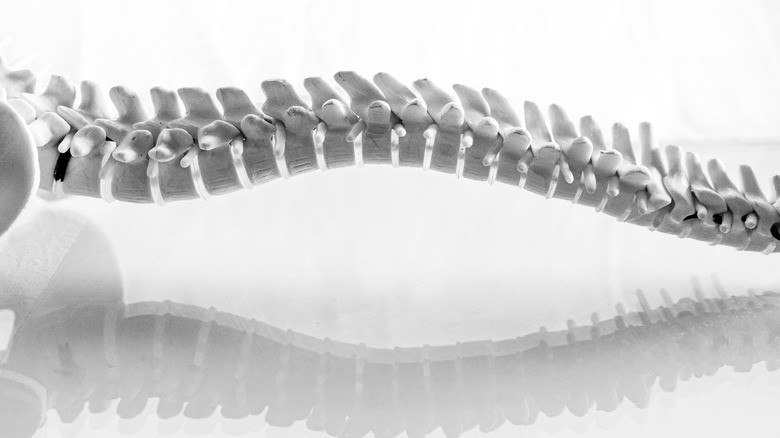The Real Reason Human Beings Aren't The Same Height All Day
Height can be a very contentious issue. In the period from 2015 to 2016, according to Centers for Disease Control and Prevention, the average height of women in the United States was 63.7 inches, and for men it was 69.1 inches. An individual's height is, of course, affected by all kinds of factors, and will differ tremendously from person to person.
One remarkable example is the iconic Robert Wadlow. According to Guinness World Records, Wadlow was the "tallest man in medical history for whom there is irrefutable evidence." He stood 8 feet 11 inches tall. He was measured and proven to be this height just weeks before his death in July 1940, and the title of tallest conclusively-proven person ever remains (at the time of writing) his. Definitively measuring somebody's height, however, isn't as easy as it may seem. Of all the fascinating facts about the human body, one of the more unusual is this: It seems that our height fluctuates over the course of a day.
Pressure on the spine can influence our height
Some things in our daily routine remain exactly the same. Resolute, unchanging. The same old commute, purchasing the same morning coffee from the same vendor ... it's the familiar way of things. Our bodies also remain the same day in, day out, don't they? Actually, this isn't the case at all. Human beings are, on average, about one centimeter taller in the morning than later in the day.
The human spine, Healthline reports, is a simultaneously tough-yet-delicate mechanism that does so much more than just support the body. The spinal cord also relays information that allows for reflex actions, so we can react to split-second dangerous situations before even knowing that we'd done so.
Physical activity can put a lot of strain on the spine, as it runs, jumps, bends, and everything else besides. This is often far from a bad thing. A paper titled "Influence of Participation in High-Impact Sports during Adolescence and Adulthood on Bone Mineral Density in Middle-aged Men: A 27-Year Follow-up Study" (via the American Journal of Epidemiology) reached the conclusion that "continued participation in impact sports is beneficial for the skeletal health of males aged 40 years." This is because the skeletal system will naturally decline as the body ages, and the spine is under particular pressure. In fact, on a daily basis, compression of the spine seems to reduce the height of human beings each day.
The effect seems much more pronounced on astronauts
Jamaica Hospital Medical Center reports that a curious sort of daily cycle seems to control this. Sitting down and taking other positions can compress the cartilage of the spine (and other areas of the body) as the day goes on, having a small but significant impact on a person's overall height.
When we're tucked up in bed at the end of a busy day, Jamaica Hospital Medical Center goes on, this effect can reverse. The vertebrae of the spine and the cartilage can uncompress, and so our heights return to their fullest, though reportedly only around .4 inches taller than later in the day.
The change is similar (though on a much smaller scale) to that which astronauts have experienced. According to the report "Space travel affects spine of astronauts, NASA study shows" (via Science Daily), leaving Earth's gravity behind can result in "an increase in body height (about two inches), thought to result from spinal 'unloading' and other changes related to the lack of gravity." These changes, and the back pain that can accompany them, may not be permanent, but they have important implications for the future of space travel and skeletal care.


